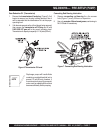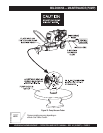
PAGE 20 — MQ-D306HA DIAPHRAGM PUMP — OPERATION AND PARTS MANUAL — REV. #3 (01/09/07)
MQ-D306HA — MAINTENANCE (PUMP)
To perform the pump vacuum test do the following:
1. Remove the pump fill cap (Figure 2), and fill the pump
with water.
2. Start the engine as outlined in the initial start-up section,
and wait for the pump to begin pumping.
3. As shown in Figure 19 (next page), place a water hose
inside the discharge opening of the pump, and turn on
the water. This flow of water into the discharge opening
will
prevent
the pump from running dry.
4. Place the
Pump Vacuum Tester
(P/N 7000030)
over
the pump suction (inlet) opening (Figure 19) with the
vacuum gauge facing upwards. It may be necessary to
apply a small amount of water around the rubber seal of
the vacuum tester to make a good suction fit.
5. Check and make sure that there are no air leaks between
the vacuum tester and the inlet port on the pump. If air
leaks are present reseat vacuum tester.
6. Run the pump for a few minutes while monitoring the
vacuum gauge. If the gauge indicates a reading between
-25 and -20 in. Hg. (inches of mercury) then it can be
assumed that the pump is working correctly.
Pump Vacuum Test
25 in. Hg (inches of mercury)
translates into 25 feet of lift at
sea
level
.
7. If the vacuum tester gauge indicates a reading
below
-20 in. Hg, it can then be assumed that the pump
is not functioning correctly, and corrective action needs
to be taken.
6. To test the
flapper valve
, shut down the engine. The
vacuum tester should remain attached to the pump
suction inlet port by vacuum. This indicates the pump's
flapper valve is seating properly to hold water in the
suction hose when the engine is stopped. This prevents
backflow and allows for faster priming when the engine
is restarted.
Pump Cleaning
After pumping water containing large amounts of dirt and
debris, perform the following:
1. Remove the drain plug from the pump housing (Figure 2)
and drain any water left in the pump.
3. Clean and remove dirt, debris from pump casing. Inspect
impeller and volute for wear. Replace any damaged or
worn parts.
Gear Reduction Oil (Transmission)
1. Change transmission oil after the first
40 hours
of
operation. Use SAE 80/90
EP gear oil.
Transmission oil
capacity is 1-1/4 pints (590 ml.). Check oil level periodically
and change oil after every
400 hours
of operation.
Connecting Rod Bearing Lubrication
1. Grease connecting rod bearing thru the access
hole (Figure 7) every 25 hours of operation.
2. Use only
premium lithium based grease
, conforming to
NLG1 Grade #2 consistency.
Connecting Rod Bearing Lubrication
1. Keep interior of pump and valves clean. Flush out
pump with clear water after operation.
2. Remove connecting rod guard occasionally and wipe
up excess grease from connecting rod bearing.
NOTE
DO NOT attempt to start the engine unless the pump has
previously been
primed
with water. Severe pump damage
will occur if pump has not been primed.
CAUTION - Priming Pump


















